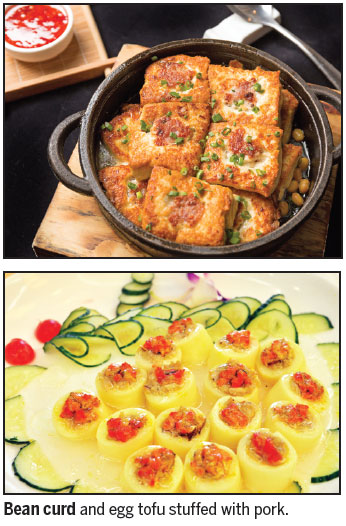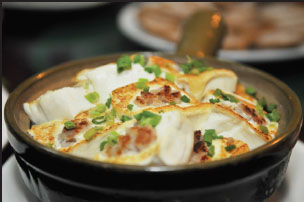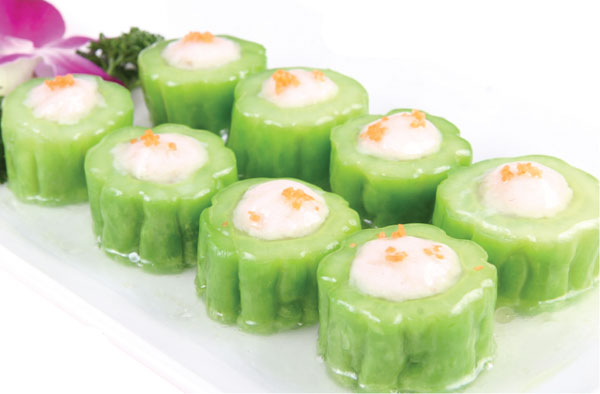Stuffed full with tradition

Editor's Note: China is divided into as many culinary regions as there are different ethnic groups. Its geographical diversity and kaleidoscopic cultural profiles contribute to the unending banquet of flavors.
Ever since the Chinese invented bean curd, they have been trying all ways to make it taste even better. On its own, bean curd is bland, but it can be paired with other ingredients with great versatility.
Thousands of years ago, some clever cook decided to make a pocket in a piece of bean curd and stuff some meat in there. The recipe was picked up by other clever cooks over the years and fine-tuned into a variety of styles that variously developed in Sichuan, Guangdong and Hunan provinces and the Guangxi Zhuang autonomous region.
There is a story about the dish's origins.
| Niangdoufu becomes a lot more than just bean curd. Photos Provided to China Daily |
An aging mother was very bothered by how quarrelsome her sons had become and she tried many times to defuse the tension between the siblings. Finally, one day, she got them to come home for dinner.
She decided to make their favorite food. One son loved tofu, while the other loved meat. She thought hard and combined meat and tofu into one dish and made bean curd stuffed with pork. Her sons loved it.
While they were eating, she took the opportunity to remind them of the power of unity. Her sons, mellowed by good food, quietly nodded. They did learn their lesson and went on to build a business empire together.
Perhaps this was one of the reasons this dish became so popular.
But there was one particular community that adopted the stuffed bean curd as its own. The Hakkas, originally "guest people" from the Central Plains, subsequently settled in the southern provinces of Fujian and Guangdong.
Hakka stuffed bean curd or niangdoufu has become a culinary style, going far beyond just that one dish. Inside the walled villages or tulou of the Hakka people, the women used to spend hours each day cutting bean curd and making the filling.
These would then be fried before being served with a savory brown gravy.

As time passed, they augmented and improved the taste by using deep-fried tofu, tofu puffs and thin layers of skin off the top of soybean milk. They also started making the filling more substantial.
Meat was mixed with fish and prawn paste, and finely minced salted fish was added to increase the umami.
It was only natural to use vegetables from their garden within the village walls, including such southern varieties like bitter melon, lotus roots, okra, aubergines, red and green chili peppers, melon, squash and pumpkin.
So, niangdoufu became a lot more than just bean curd. It became a dish that included stuffed vegetables and other tofu products.
Then, the Hakkas joined the diaspora to Southeast Asia, and they brought their stuffed bean curd with them.
Away from the motherland, the ingredients and cooking method evolved once again, adapting to local conditions.
In the Southeast Asian archipelago, fish was more easily available than meat, and pork became more a seasoning than the main ingredient.
Other emigrants from Chaoshan also contributed to the dish, teaching the Hakkas how to make fish paste that could be used as filling.
In Singapore and Malaysia, two styles of niangdoufu became popular.
The Hakkas retained their original recipe, using fish paste as the foundation of the filling and adding meat and salted fish. They kept the selection simple, sticking to bean curd products mainly, with fewer vegetable choices.
They also developed garlic-based savory sauces and served it with chili, pounded and fried, very much like a cross between a sambal and hot oil. They also served their tofu with platters of a thick sweet hoisin sauce.
The fish-paste stuffed niangdoufu is very popular with office ladies and those who prefer a lighter diet, because there are plenty of vegetables to choose from.
A food stall offering niangdoufu is a colorful display, and these days the modern food courts in Singapore will almost invariably have a vendor offering this.
Apart from the freshness of the vegetables and bean curd products, and the sweet fish filling, diners also look at the soup that comes with the pieces.
It has to be brewed from soybeans and dried anchovies. The beans give the broth a natural sweetness, and the dried anchovies give it depth.
Sometimes, the soup is made with sprouted soybeans, which adds a similar flavor but is much easier to manage because the beans do not need to be rehydrated.
There is a little ritual to ordering.
You line up at the stall with a large bowl and little tongs. Then, you select what you need - fish balls, tofu, stuffed vegetables, maybe pickled squid pieces, a sheet of laver, a bundle of konnyaku, your choice of water-cress, cabbage or Shanghai greens.
The stall holder will next ask you to choose from rice vermicelli, thick or thin noodles, or glass noodles. Then you have to tell him if you wanted the niangdoufu in soup, or served dry.
The pieces in your bowl are expertly blanched to cook them, and the noodles added to the bowl. The large pieces of stuffed beancurd and vegetables are then snipped into bite-sized portions with scissors.
Fried golden garlic, toasted sesame seeds, a savory sprinkle of soy sauce and sesame oil, and you have a delectable, healthy meal.
By the side of the stall will be tubs of chili and hoisin sauces from which diners can help themselves.
In China itself, you'd be hard put to find vegetables served with beancurd outside the Hakka walled villages. It is interesting to see how one dish has so evolved in its journey through both history and to different places. Classic dishes can easily withstand the test of time.
paulined@chinadaily.com.cn
Homemade Stuffed Bean Curd
1 box of silky tofu, carefully cut into squares
200g minced pork belly
50g dried salted fish, bones removed, minced
1 teaspoon cornstarch
1 tablespoon minced shallots
3-4 cloves garlic, peeled and minced
2 tablespoons soy sauce
1 tablespoon Chinese cooking wine
1 teaspoon sesame oil
Salt and sugar to taste

1 cup water plus 1 tablespoon cornstarch
In a mixing bowl, mix minced pork, minced salted fish and teaspoon cornstarch together. Mix vigorously in one direction till it gets sticky. Add the minced shallots and mix well.
Lay out the tofu squares in a steaming platter. Use a teaspoon to scoop out a hollow in the center of each tofu square. Place a heaped spoonful of meat filling inside.
Using your wet hands, smooth over the top. Steam over high heat for 10 minutes.
While tofu is steaming, fry the garlic in enough oil to get it crisp and golden. Drain and set aside.
Pour off excess oil. Heat up soy sauce, Chinese wine and sesame oil in the same pan. Dissolve the cornstarch in water and add to the pan. Cook until sauce is translucent. Sprinkle on half the fried garlic.
Remove tofu from steamer and pour off any water on the plate. Pour the bubbling brown sauce on top and sprinkle with remaining garlic and some spring onions.
(China Daily European Weekly 07/21/2017 page19)
Today's Top News
- ?Typhoon Wipha pummels Guangdong province
- Japan's ruling coalition faces tight election test
- 'Pet' major launched as demand surges
- EU's sanctioning of Chinese financial institutions unjustifiable
- China coastal regions brace for Typhoon Wipha
- Premier stresses high-quality implementation of major national projects































